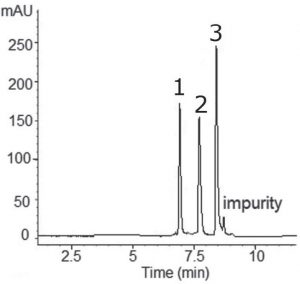IMP, IDP, and ITP Analyzed with HPLC
The figure shows the optimized separation of ITP (Inosine 5’-monophosphate), IDP (Inosine 5’-diphosphate) and IMP (Inosine 5’-triphosphate) in the order of increasing Phosphate content similar to anion exchange. The presence of at least one impurity near ITP and possibly a second near IMP precluded accurate determination of peak symmetry.


Peaks:
1. IMP – Inosine 5’-monophosphate
2. IDP – Inosine 5’-diphosphate
3. ITP – Inosine 5’-triphosphate
Method Conditions
Column: Cogent UDA™, 4µm, 100Å
Catalog No.: 40031-05P-2
Dimensions: 2.1 x 50mm
Mobile Phase:
—A: DI Water / 16.0mM Ammonium Formate
—B: 90% Acetonitrile / 10% DI Water / 16.0mM Ammonium Acetate
Gradient:
| Time (minutes) | %B |
| 0 | 100 |
| 1.5 | 100 |
| 13 | 30 |
| 20 | 30 |
| 20.1 | 100 |
Temperature: 25˚C
Post Time: 3 minutes
Injection vol.: 1 μL
Flow rate: 0.4mL / minute
Detection: UV @ 254nm
Sample Preparation: Stock Solution: 1mg / mL solutions in DI Water. Samples were diluted 1:10 into 50% Acetonitrile / 50% DI Water mixture. Before injection, samples were filtered through a 0.45µm Nylon Syringe Filter (MicroSolv Tech Corp).
t0: 0.7 minutes
Note: Deficiency of the enzyme ITP Pyrophosphohydrolase is a common genetic defect in human populations and has aroused recent interest for its putative pharmacogenetic relevance to Thiopurine therapy. The enzyme is part of a nucleotide ‘‘futile cycle’’, which converts IMP to IDP and ITP then back to IMP.
Attachment
No 261 Separation of Inosine Nucleotides pdf 0.2 Mb Download File


